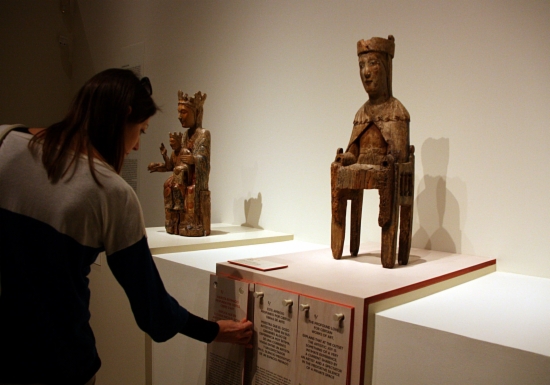World’s greatest Romanesque Art collection through Antoni Tàpies’ eyes
Catalonia’s National Museum of Art (MNAC) proposes a new way to discover its Romanesque Art collection – which is the most important in the world – through the eyes of an important figure of European Contemporary Art: the Catalan Painter, Sculptor and Essayist Antoni Tàpies (1923 - 2012). The Barcelona-based museum has carried out a “small intervention” in the halls of the Romanesque collection so that visitors are able to see the exhibited works with interpretation elements and views linked with Tàpies’ work and thoughts. In addition, the MNAC is also exhibiting one of the artist’s most emblematic works: the Romanesque Painting with Barratina (Pintura Romànica i Barretina, 1971)

Barcelona (ACN).- Catalonia’s National Museum of Art (MNAC) has carried out a “small intervention” in the halls of the Romanesque collection so that visitors are able to see the exhibited works through the eyes of an important figure of European Contemporary Art: the Catalan Painter, Sculptor and Essayist Antoni Tàpies (1923 - 2012). With this project the MNAC proposes a new way to discover its Romanesque Art collection, which is the most important in the world. The Barcelona-based museum offers visitors “new views” and interpretation elements on this artistic period through the perception and thoughts of Catalan artist Antoni Tàpies. ‘Romanesque Art as seen by Antoni Tàpies’ strongly conveys its influence on the artist’s training and sensitivity, while staying true to his perception. Indeed, Tàpies viewed Romanesque art as the “anticipation of modern art”. Furthermore, at the end of the permanent exhibition of the Romanesques collections, the MNAC is now also displaying one of Tàpies’ most emblematic works: the Romanesque Painting with Barratina (Pintura Romànica i Barretina-1971).
Visitors of the collection are invited to reflect on Antoni Tàpies’ relationship with Romanesque Art. Direct quotes from the Catalan artist or people he admired are displayed on the walls, as well as some masterpieces from Tàpies’ private art collection. However, only a single work executed by Tàpies himself will be exhibited. This painting, displayed at the end of the tour, is the famous Romanesque Painting with Barratina (1971)
The intervention’s Curator, Gemma Yla-Català, explained that the Romanesque Painting with Barratina was considered a mural assemblage. She insisted that this piece acted as a “link” between the works of the past, of that historical period, and the contemporary works of Tàpies. “The Catalan beret symbolizes his attachment to his country, a feeling he never let go”, she added.
The intervention on the Romanesque Art collections aims at providing a contemporary approach to Medieval Art, while conveying the full complexity of Tàpies’ artistic perception, linking it with works of the past. According to the Director of MNAC, Pepe Serra, it is as if the visitor entering the Romanesque Collection “had put Tàpies’ glasses on”. They can consequently see the works through the artist’s impressions, experiences and influences in relation to this period.
“Opening a dialogue” between MNAC’s collections and contemporary artists
This intervention is part of the MNAC’s project to “open a dialogue” between the museum’s collections and contemporary artists, and to reveal “the close relationship between the avant-garde artists and traditional art in our country”, explained Serra.
This intervention was unveiled just when the MNAC was ending an exhibition on the Catalan contemporary artist himself, ‘Tàpies from Within’, which had been on show since the 21st of June. This first major retrospective spanning the entire career of the artist was co-organised by the MNAC and the Antoni Tàpies Foundation.